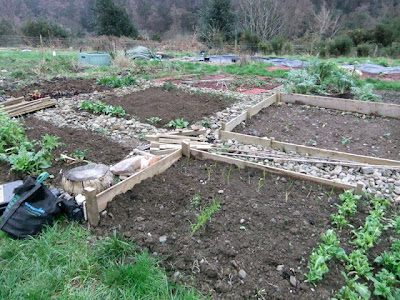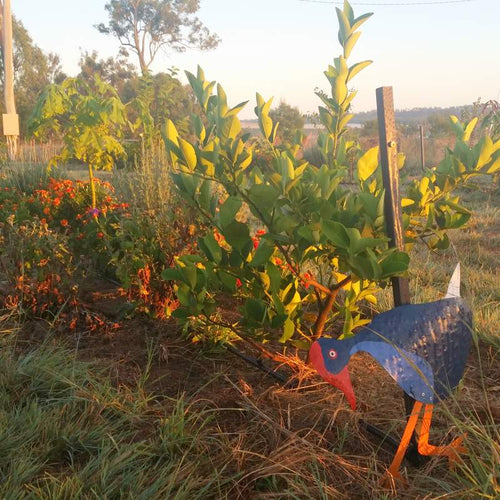Getting started with growing your own - Lovely Greens
Today, as part of my series of interviews with bloggers who grow their own, I have an interview with Tanya of Lovely Greens. Tanya grows veggies, herbs, and flowers in her garden and allotment in the Isle of Man – that’s a lovely little island located in the middle of the Irish Sea. In addition to gardening, she keeps hens and honeybees for home-grown eggs, honey, and beeswax and has plans to one day add goats to the menagerie. Tanya uses her produce both on the table and as ingredients for her handmade bath and beauty products which she sells online, at local shops, and at her Farmers Market stall. For her growing is a passion and one that she’s keen to get more people involved in – especially beginners.
Farmer Liz: Tell me about your garden and climate
FL: When and why did you start growing your own?
T: Having a garden was always something we had at home growing up. Though my mother’s efforts weren’t the most successful, both my Grandmothers and my Great Grandfather had fabulous gardens overflowing with peas, beetroot, potatoes, Swiss Chard, and the rest of the usual suspects. Children might not seem like they’re learning much from digging up new potatoes or helping weed (i.e. destroy) the onions but these experiences really do sink in. After nearly two decades of avoiding getting dirt under my manicured fingernails I was drawn back and have been passionately growing for the past five years. For me, growing is both an interest as well as a way to ensure that our produce is organic, clean, and has low food miles.
Farmer Liz: Tell me about your garden and climate
Tanya: The Isle of Man has a rather odd climate, being that it doesn’t ever get really hot or really cold. Summer temperatures are generally at or under 20C and winter between 5-10C which means that it can be challenging to grow all the hot climate produce we’ve come to love – aubergines, tomatoes, and peppers to name a few. It’s not all doom and gloom and it’s really just a matter of finding out what grows well and then use those crops as a foundation on which to experiment and add others.
It can also rain here – a lot. Though it’s mainly the winter months that are the wettest, last summer was a complete washout for all of Britain. Heavy flooding and continuous rain kept many people indoors and our allotment was pretty much abandoned from June onwards. There are places in the world where rain is seen as a blessing and a chance to fill reservoirs and tanks but here you just hope it drains from the land and makes its way to the sea quickly. The positive side to all this precipitation is that our predominantly clay soil latches on to the moisture and if your plants are mulched well you never have to water them, even after long days of summer sunshine. Being this far north means that in the summer the sun can rise before 5am and set close to 10pm.
It can also rain here – a lot. Though it’s mainly the winter months that are the wettest, last summer was a complete washout for all of Britain. Heavy flooding and continuous rain kept many people indoors and our allotment was pretty much abandoned from June onwards. There are places in the world where rain is seen as a blessing and a chance to fill reservoirs and tanks but here you just hope it drains from the land and makes its way to the sea quickly. The positive side to all this precipitation is that our predominantly clay soil latches on to the moisture and if your plants are mulched well you never have to water them, even after long days of summer sunshine. Being this far north means that in the summer the sun can rise before 5am and set close to 10pm.
 |
| Tanya's allotment garden beds ready for planting |
For people with both the land and the money, a polytunnel is your best bet for getting a decent harvest but for us it isn’t an option at the moment. That saying, we produce most of our own summer produce and have plenty of potatoes, greens, onions, and preserved veggies to last throughout the winter. The trick is working with the climate and growing produce that you know will see you through. If you randomly select seeds based on the pictures on the front or what you normally would purchase at the shops you can set yourself up for disappointment.
FL: When and why did you start growing your own?
T: Having a garden was always something we had at home growing up. Though my mother’s efforts weren’t the most successful, both my Grandmothers and my Great Grandfather had fabulous gardens overflowing with peas, beetroot, potatoes, Swiss Chard, and the rest of the usual suspects. Children might not seem like they’re learning much from digging up new potatoes or helping weed (i.e. destroy) the onions but these experiences really do sink in. After nearly two decades of avoiding getting dirt under my manicured fingernails I was drawn back and have been passionately growing for the past five years. For me, growing is both an interest as well as a way to ensure that our produce is organic, clean, and has low food miles.
 |
| Tanya's chickens |
FL: From your experience, what’s the best way to start growing your own?
T: As the secretary of our allotment association I’ve seen more than a few enthusiastic people start up work only to give up and toss in the spade after only a few months. I think it’s because a lot of beginners don’t anticipate how much hard work it is combined with setting up unrealistic expectations for their first year. The glut of gardening programmes showing perfectly weeded and productive gardens with Alan Titchmarsh or Monty Don effortlessly plucking raspberries in freshly pressed Chinos doesn’t help the matter. My recommendation is to get stuck in to a small area and grow veggies that are easy, that produce quickly, are resistant to disease, and that you enjoy eating. If you have the opportunity to grow on a larger piece of land it will also give you the opportunity to observe it for a year to see what opportunities and challenges you might have to contend with when you eventually start growing there.
FL: What are your top 5 favourite easy and productive plants for beginners to grow?
T: Lettuce – it’s dead easy to grow from seed and will give you produce you can take home to the table in no time. In winter you can even grow ‘Cut and Come Again’ lettuce in seed trays in the house.
New potatoes – don’t mess around with maincrops in your first year if your area is known to suffer from blight. New potatoes crop before blight becomes an issue so are both delicious and something to count on.
T: As the secretary of our allotment association I’ve seen more than a few enthusiastic people start up work only to give up and toss in the spade after only a few months. I think it’s because a lot of beginners don’t anticipate how much hard work it is combined with setting up unrealistic expectations for their first year. The glut of gardening programmes showing perfectly weeded and productive gardens with Alan Titchmarsh or Monty Don effortlessly plucking raspberries in freshly pressed Chinos doesn’t help the matter. My recommendation is to get stuck in to a small area and grow veggies that are easy, that produce quickly, are resistant to disease, and that you enjoy eating. If you have the opportunity to grow on a larger piece of land it will also give you the opportunity to observe it for a year to see what opportunities and challenges you might have to contend with when you eventually start growing there.
FL: What are your top 5 favourite easy and productive plants for beginners to grow?
T: Lettuce – it’s dead easy to grow from seed and will give you produce you can take home to the table in no time. In winter you can even grow ‘Cut and Come Again’ lettuce in seed trays in the house.
New potatoes – don’t mess around with maincrops in your first year if your area is known to suffer from blight. New potatoes crop before blight becomes an issue so are both delicious and something to count on.
 |
| potatoes |
Globe Artichokes – I grew these from seed in 2010 and they’ve been both low-maintenance and producing pretty much year-round ever since. When you spot what prices they’re going for in the shops you’ll be patting yourself on the back for growing your own.
 |
| globe artichokes |
Rhubarb – They seem to thrive on neglect and one or two plants will give you more than your fair share of stems. I use mine to make chutney, desserts, and rhubarb wine. Another interesting fact about my rhubarb is that I didn’t grow it from crowns or a plant from the garden centre but from seeds! The variety is called ‘Victoria’ and I’ve even passed on the extra seeds to an experienced gardener friend. Though she was dubious at first, she was pleasantly surprised to find that they grew true. She was even harvesting a few stems in the first summer, though you should really wait a year to harvest normal quantities.
 |
| rhubarb |
Raspberries – It’s taken me years to finally order my own but I’ll be planting my own canes shortly. The reason I’m giving them a go is that they’ll provide a good wind break and a very easy crop of delicious berries. It’s one of the crops I’ve seen flourish on neglected plots so should be easy for beginner growers – just make sure that your growing conditions are right for them.
 |
| Jerusalem artichoke shoots - beware! |
PS – There are some really easy crops to grow out there but make sure that you and your family will enjoy eating them before you make an investment in gardening space for them. Jerusalem Artichokes are one that I’d specifically advise caution against – though I think they taste great, my husband doesn’t like them at all. They can cause painful gas to a good proportion of people and I don’t think I’ll ever live down the misery I inflicted on an allotment neighbour who took some of mine home. They’re also extremely invasive and will take over an area in no time. So beware of Sunchokes folks!
FL: thanks so much Tanya, some wonderful information for everyone to think about! Now if you'd like to comment, please head over to Tanya's blog, Lovely Greens, and tell us what you think :) Also check out all the info about soap, bees and chickens!
 |
| Tanya's bees |
The other interviews:
Gavin of the Greening of Gavin
Ohio Farmgirl from Adventures in the Goodland
























Leave a comment